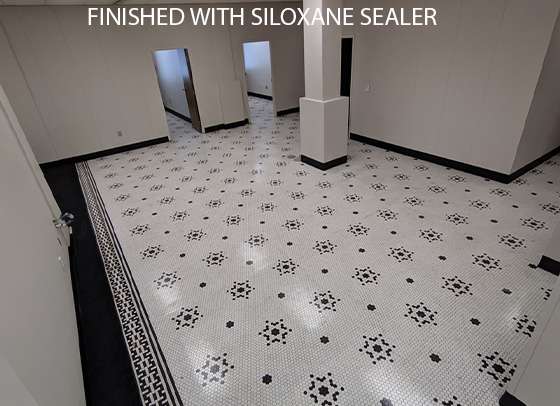CASE STUDIES
Mosaic Tile Covered in Carpet for Decades
We received a phone call from the Attorney General’s offices in Topeka, Kansas about mosaic tile that had been covered in carpet for decades. Our clients were thrilled to discover the beautiful mosaic tile when the carpet was removed during remodeling of the Kansas State Capitol building, also known as Kansas Statehouse. However, our clients were not sure if the floor could be restored, because it was in such poor condition. The tile and grout lines were covered in mastic, a very strong adhesive that had been used to secure the carpeting. The floor was extremely dirty, and the finish was scratched due to abrasives from foot traffic that had fallen through the carpet and padding over the years.
Working in secure facilities is not uncommon for the team at Victory Cleaning Systems. We were happy to take on the special challenges involved in this unique historical restoration project.
Mastic Removal and Tile Grout Restoration
Going out of our way to minimize inconvenience to the employees and people coming in and out of this government building, we brought an array of professional equipment and solutions for this job, including a special soy-bean based stripper, which is free of methylene chloride and is extremely low odor.
First, we applied the stripper and allowed ample dwell time for the mastic to dissolve. Then, we properly disposed of the mastic and stripper solution. Any remaining buildup was safely and effectively dislodged using a floor machine designed for the stripping of hard surface floors. We finished up with an auto scrubber, pH-neutral cleaner, and a degreaser. These processes prepared the floor for our remaining restoration process, which involved treating the exposed concrete with black epoxy, and then sealing the tile and grout with a clear sealer. Here are the details.
Epoxy Installation and Clear Sealing with Siloxane Sealer
During the Kansas Statehouse renovation project, a few walls were removed, exposing sections of floor where no tile had been installed. Part of our restoration work was to make sure these patches of bare concrete were aesthetically appealing and integrated with the overall look of the existing tile, as well as a black cove base that would be installed after our restoration work. We ground the concrete to ensure proper adhesion and then applied black epoxy. Our final step was to install our proprietary siloxane-based topcoat. This extremely long-lasting, no-strip sealer covered both the tile and the grout lines, creating a glossy, sanitary surface that would be very easy to clean and maintain. For a large, commercial property, our sealer was a perfect alternative to traditional acrylic (wax) coatings that have to be continuously stripped and reapplied.
This project took just a few days to complete, on time and on budget. Our clients were able to maintain their normal business hours, with no interruption to their normal activities.




